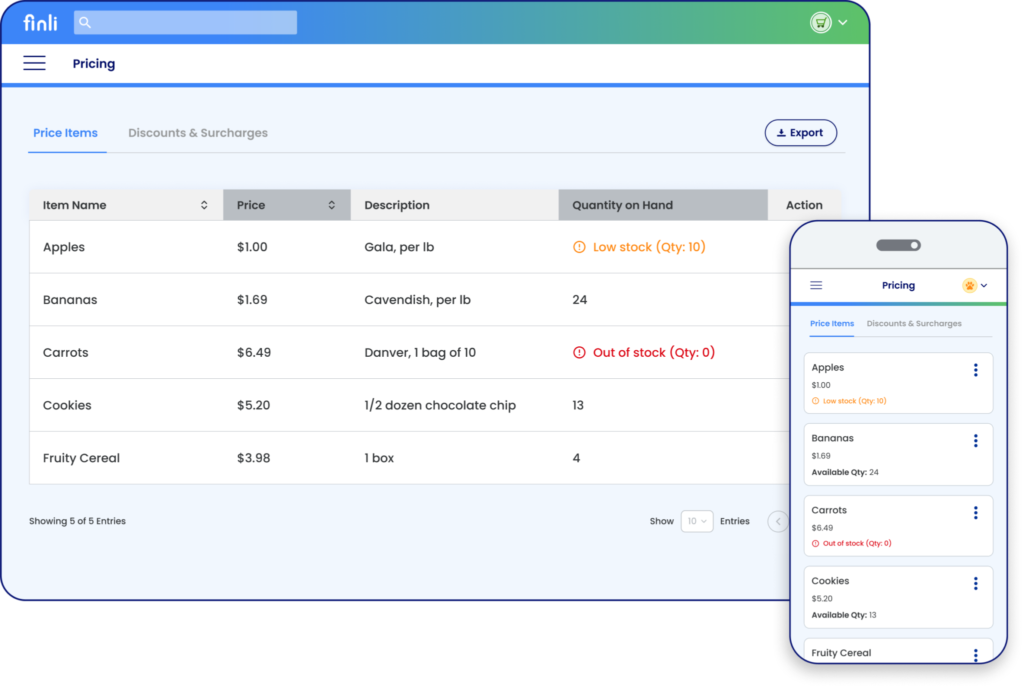What is Inventory Management?
Inventory management is the process of tracking and optimizing the physical stock levels of items your business carries and sells. Even if your business is primarily service-based, you might sell items in limited quantities – like t-shirts!
Finli’s inventory management tool automatically updates stock quantities based on the invoices you issue to customers. When you include a product with inventory tracking enabled on any invoice, we’ll immediately deduct that amount from your ‘inventory on hand’. Finli makes it easy for you to stay on top of your stock levels!
Keeping tabs on inventory with Finli
Tracking your stock with Finli takes only a few simple steps:
- Create a Pricing Item – Name your item, set up how much it costs, and add a brief description.
- Track Inventory – Indicate the amount of merchandise you have in stock and let invoices automatically keep this up to date.
- Get Reminded – Finli will remind you when you’re running low and it’s time to reorder!
Finli’s inventory management feature is built right into the rest of our invoicing and payment collection platform, so you can manage all the important parts of your business in one place.
Key aspects of inventory management
Inventory management is a very important part of successfully running a business and optimizing your stock quantities. Keeping too much or too little inventory on hand can have negative effects on your ability to effectively manage cash and sell merchandise.
Here are a few things to keep in mind regarding inventory management:
- Ordering: Determining when to order products, and in what quantity, is a crucial part of inventory management. You can use various forecasting techniques to predict future demand and determine optimal order quantities.
- Stock control: Tracking the amount of inventory on hand and which products or services (we call them pricing items on Finli) are in stock.
- Demand forecasting: Predicting customer demand to avoid insufficient stock or overstock situations.
- Inventory turnover: This is a measure of how frequently inventory is sold and replaced over a given period.
- Safety stock: Keeping extra stock to cover unexpected changes in demand or supply.
Effective inventory management is critical because it allows you to meet customer demand without delay while keeping inventory costs low. Poor inventory management, on the other hand, can lead to either stockouts (running out of products) or excessive stock, both of which can be costly and can negatively impact customer satisfaction.
Importance of inventory management for a business
Inventory management is essential for businesses of all sizes. It helps businesses to:
- Avoid stockouts and lost sales. When a business has the right amount of inventory on hand, it can fulfill customer orders quickly and easily. This helps to prevent stockouts, which can lead to lost sales and unhappy customers.
- Minimize carrying costs. Carrying costs are the costs associated with holding inventory, such as storage costs, insurance costs, and depreciation costs. Effective inventory management can help businesses to minimize carrying costs by ensuring that they do not have too much inventory on hand.
- Improve cash flow. When businesses have a good understanding of their inventory levels, they can better manage their cash flow. This is because they can avoid overstocking inventory, which can tie up cash that could be used for other purposes.
- Reduce risk. Effective inventory management can help businesses to reduce risk by minimizing the chances of stockouts and lost sales. It can also help businesses to manage the risk of theft, damage, and obsolescence.
- Improve customer service. When businesses have the right amount of inventory on hand, they can provide better customer service. This is because they can fulfill customer orders quickly and easily, and they can also offer a wider range of products to choose from.
Overall, inventory management is a critical component of any successful business. By effectively managing your inventory, the business you run can improve its bottom line, increase customer satisfaction, and reduce risk.
Here are some specific examples of how inventory management can benefit businesses:
- A small retailer can use inventory management to ensure that they have the right amount of inventory on hand to meet customer demand during the holiday season. This can help them to avoid stockouts and lost sales, which can lead to increased profits.
- A manufacturer can use inventory management to track the flow of materials through their production process. This can help them to identify bottlenecks and inefficiencies, which can lead to cost savings.
- A wholesaler can use inventory management to forecast demand and ensure that they have the right amount of inventory on hand to meet the needs of their customers. This can help them to maintain a good relationship with their customers and avoid lost sales.
No matter what type of business you have, effective inventory management can help you improve your bottom line, increase customer satisfaction, and reduce risk.
$39/month
While competitors might add extra-paid features to their premium plans, Finli makes it easier and more predictable to run a business. Our pricing model is always simple and affordable.
Our flat fee of $39/month includes inventory management as well as all invoicing, digital payment collection, CRM, communications and reporting tools.
Try Finli risk free for 30 days.





